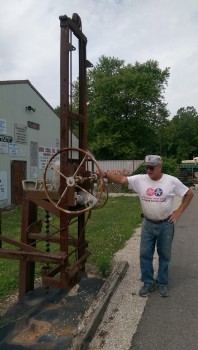Indiana at 200 — King Coal
By ANDREA NEAL
 Coal is to Indiana what oil is to Texas. Since the mid 1800s, it’s been the fuel that powers the Hoosier economy.
Coal is to Indiana what oil is to Texas. Since the mid 1800s, it’s been the fuel that powers the Hoosier economy.
“We get 85 percent of our energy from coal,” explains Indiana Coal Council President Bruce Stevens. “That’s huge because Indiana is the number one manufacturing state in the nation.”
A fossil fuel millions of years in the making, coal is essentially combustible rock formed by dead plant material. Some is near the surface and easily obtained through strip mining. The rest is deep beneath the earth and must be mined underground. Southwest Indiana has plenty of both.
Although coal was discovered in the 1700s along the banks of the Wabash River, there was no organized effort to mine it until 1825 in Warrick County, according to “Indiana in the Civil War Era” by Emma Lou Thornbrough.
In the 1830s, Perry County had the first of many “company towns” whose existence depended on coal. Miners employed by the American Cannel Coal Company — and their families — lived in cabins owned by the boss and did all their shopping at a company-owned store.
![]() An early study identified 18 counties in Indiana with sizable coal reserves, extending south from Vermillion County to the Ohio River and stretching from Posey to Perry along the state border. In 1873, Governor Oliver P. Morton proclaimed that their vast mineral wealth was “more valuable than the gold and silver mines of California, Colorado or Nevada.”
An early study identified 18 counties in Indiana with sizable coal reserves, extending south from Vermillion County to the Ohio River and stretching from Posey to Perry along the state border. In 1873, Governor Oliver P. Morton proclaimed that their vast mineral wealth was “more valuable than the gold and silver mines of California, Colorado or Nevada.”
He was right. By 1900, coal was the country’s fuel of choice, used to power steamships and railroad engines, to generate electricity and as an essential ingredient for making iron and steel (Indiana coal is not suitable for metallurgy, so the Northwest Indiana steel industry had to buy its coal elsewhere). In 1950, the U.S. Geological Survey reported that the value of coal production in Indiana exceeded $100 million, more than that of all other natural resource industries combined.
In the second half of the 20th century, demand for coal nationally began to fall as trains switched from coal power to diesel fuel and homes converted to oil or gas furnaces. Starting in the 1970s, the federal government set rules on air quality, which required coal-fired plants to install cleaning equipment to reduce pollutants released into the atmosphere. This especially affected Indiana coal, which has high sulfur content and is dirtier than the coal found in western states.
Today, natural gas is displacing coal as an energy source in much of the country but not Indiana, which is the nation’s second largest consumer of coal behind Texas. In 2014, 15 companies operated underground and strip mines in 10 counties employing 2,370 Hoosier miners and producing 39 million tons. As for the future of the industry, Stevens says it will depend on environmental rules imposed by the government and technological innovations.

Aja Mason, a retired coal worker, is curator at the Museum of the Coal Industry, which occupies the site of a former coal mine in Lynnville.
The Museum of the Coal Industry in Lynnville in Warrick County maintains an extensive collection of mining equipment, safety helmets, union memorabilia and other items documenting the history of coal in Indiana. Visitors can climb aboard a switcher locomotive that picked up coal cars at the Peabody Lynnville Mine, sit at the control panel of a 3,270 dragline built for AMAX Coal or walk through a replica company store. A memorial wall remembers those who have died while on the job, a recognition that coal mining — despite modern safety enhancements — remains one of the most dangerous occupations in the country.
Directions: The Museum of the Coal Industry is located on SR 68, 1 mile west of Lynnville in Warrick County.
EDITORS NOTE: This is a series of essays leading up to the celebration of the Indiana Bicentennial In December 2016. The essays focus on the top 100 events, ideas and historical figures of Indiana, in chronological order, tying each to a place or current event in Indiana that continues to tell the story of the state.
Andrea Neal is a teacher at St. Richard’s Episcopal School in Indianapolis and adjunct scholar with the Indiana Policy Review Foundation. She has written extensively about taxes, good governance, higher education, civic education and K-12 reform. Contact her at [email protected].
Indiana Policy Review Foundation is a non-profit education foundation focused on state and municipal issues.

